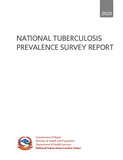Please use this identifier to cite or link to this item:
https://hdl.handle.net/20.500.14356/753| Title: | National tuberculosis prevalence survey report |
| Authors: | MoHP |
| Citation: | Ministry of Health and Population; Department of Health Services; National Tuberculosis control Center |
| Issue Date: | 2020 |
| Publisher: | Ministry of Health and Population; Department of Health Services; National Tuberculosis control Center |
| Keywords: | Tuberculosis Survey Nepal |
| Abstract: | Executive Summary:Introduction: The National TB prevalence survey 2018-19 was the first-ever nationally representative TB survey carried out to understand the actual TB disease burden in the general population in Nepal. The survey also measured the health-care seeking behaviour and service utilization among survey participants. The survey estimated the prevalence of TB in Nepal based on the direct survey findings of bacteriologically confirmed pulmonary tuberculosis among ≥ 15 years population in Nepal. Methodology: Multistage cluster sampling was designed along the WHO TB prevalence survey handbook with primary sample size of 57 589 in 99 clusters. Four primary strata were hill, mountain, terai (flat lands), and Kathmandu valley, each of which was further divided into rural and urban clusters, and further into small, medium, or large clusters (based on population size). Probability proportional to size (PPS) was used for clusters sampling. Data was collected from 28th April 2018 to 16th June 2019. All eligible participants were screened using X-ray and symptoms and those suggestive of TB, by either of the screening tool, were eligible for sputum. Spot and morning samples were collected for all eligible for sputum and tested by smear and Xpert MTB/RIF testing and additional morning sample was also collected from 50% of eligible participants and those having TB treatment history for culture. Results: 91.9% (54 200 out of 58 956) of the eligible population participated in the survey. Among 54 200 who participated, 99.9% had symptom screening results and 96.7% had chest X-ray results, 28.1% (15 212 out of 54 200) among those who participated were eligible for sputum, and 98.6% (15 011 out of 15 212) submitted at least one sample. Xpert MTB/RIF was used as the primary diagnostic tool for all sputum eligible participants and culture was done for 50% of the participants eligible for sputum and among all those with a history of TB. 99.9% of those who submitted sputum had at least one valid result of Xpert MTB/RIF. Results of health-seeking behavior were available for all 3 022 participants who had TB symptoms and results of TB service utilisation were available for all participants with history of TB (58 current TB, 1 767 with past TB) 225 cases (direct cases before imputation) were identified as PS cases (6.2% rifampicin resistance). The average number of cases per cluster was 2.3, but the distribution was not homogeneous. More than 70% (of 225) showed abnormal chest X-ray without any symptoms. Bateriologially confirmed pulmonary TB prevalence aged ≥ 15 years was 374.5 (307.6 - 441.4) per 100 000 population. Based on the survey results, overall TB (all forms and all ages) burden was re-estimated. The revised estimate of prevalence rate was 416.3 (95% CI 314.1 – 518.5) and the incidence rate was 245.1 (95% CI 147.4 – 367.3) per 100 000 population for 2018. Although there was a significant annual decline of 3% incidence over a decade, the TB burden is much higher (1.6 times higher incidence and 1.8 times higher prevalence) than previously estimated. EXECUTIVE SUMMARY N A T I O N A L T U B E R C U L O S I S P R E V A L E N C E S U R V E Y R E P O R T x v The majority of symptomatic didn’t seek health care services and were mostly from the mountainous region and low socio-economic status. Those not seeking care were higher among survey TB cases (45.0%, 27 out of 60) as compared to non-survey TB cases (43.1%, 1276 out of 2962) and reasons were mostly inconvenient in time and financial reasons. More than 80% took medication at home or health facilities under supervision. Among participants with history of TB, 60% chose government health facilities as the first choice for TB services, followed by the private sector, and health services outside the country. Most males of the working-age group from terai and hill region were the ones who were taking treatment services outside the country. Conclusion: National TB prevalence Survey 2018-19 suggested a significant impact of efforts on TB epidemiology in Nepal that led to an estimated 3 % annual reduction of TB incidence in the last decade. However, the survey also identified a higher TB burden than previously estimated. The survey also found emerging challenges such as higher TB prevalence in the aging population and TB in hard to reach areas. The survey also indicated that more TB cases could be detected by using screening tools like X-ray and rapid diagnostic tools like Xpert MTB/RIF tests. |
| URI: | http://103.69.126.140:8080/handle/20.500.14356/753 |
| Appears in Collections: | NHRC Research Report |
Files in This Item:
| File | Description | Size | Format | |
|---|---|---|---|---|
| RES01041-MoHP-2020.pdf | Download Full Text Report. | 11.83 MB | Adobe PDF |  View/Open |
Items in DSpace are protected by copyright, with all rights reserved, unless otherwise indicated.
